Kia Sorento Vs Sportage: How Are the Crossovers Different? Which One is Right for You?

The Kia Sportage and Kia Sorento may look a bit similar, but these two crossovers are actually quite different.
The Sportage is a compact crossover, while the Sorento is a mid-size. For this reason, these two crossovers have different powertrain options, a different number of seats, and are offered at different price points.
Get a Quote on a New Kia Sorento or SportageIn this post, we’ll explain the key differences between the Kia Sorento and Kia Sportage and compare them across a variety of categories. This will hopefully leave you with enough knowledge to decide which of these vehicles is better suited to you and your specific needs and lifestyle.
Scroll below to learn all about the Kia Sportage and Kia Sorento.
*This article focuses on 2019 Kia Sportage, as not all information for 2020 model was available at the time of writing. We will update the article to include the 2020 updates, which were mainly limited to cosmetic changes, once all necessary info becomes available.
Kia Sorento vs Sportage
Design
Kia Sorento: The Sorento is larger than the Sportage, so its proportions are a bit more drawn out. It received an update for 2018, which is good, and it thus appears relatively modern. We actually prefer the more mature look of the Sorento to the youthful Sportage, with the various brush metal/chrome elements making it appear a bit more upmarket. From some angles, however, it looks a lot like the Kia Sedona minivan.
Kia Sportage: As we mentioned above, the Sportage is more taut and upright than the Sorento, with a rather wide and tough-looking stance. Both of these crossovers feature Kia’s ‘Tiger Nose’ grille, though, along with a narrow greenhouse. Some shoppers may not like the Sportage’s headlight location, as their placement in relation to the grille gives it a bit of a surprised look, in our opinion. The Sportage was updated for 2020 (the updated model is pictured here), so some models you find at dealers may still be pre-update models from 2019 and earlier.
Bottom Line: Both of these crossovers look fairly similar, although the Sorento is the more handsome of the two with its traditional headlight placement and large brush metal-look grille giving it a more mature and upmarket appearance that may be better suited to older buyers.
Space/Practicality
Sorento: The Sorento is a mid-size three-row crossover with seating for seven. It has a total interior volume of 154.2 cubic feet and a total cargo volume 73 cu-ft with the second and third rows folded down. Kia claims front headroom of 39.5 inches, middle row headroom of 39.3 inches and third-row headroom of 36.3 inches. Front legroom comes in at 44.1 inches, middle legroom is 39.4 inches while third-row legroom is 31.7 inches.
Sportage: The Sportage is a compact two-row crossover with seating for five. It has a total interior volume of 129.3 cu-ft and a cargo volume of 30.7 cu-ft with the second row up, and 60.1 cu-ft with the second row folded down. Kia claims front headroom of 39.3 inches and second-row headroom of 39.1 inches. Front legroom comes in at 41.5 inches and middle legroom is 38.2 inches.
Bottom Line: The Sorento is the larger of these two vehicles by a fair bit. If you have a larger family or frequently carry lots of passengers or cargo, it will definitely be the crossover for you. If you don’t have a large family and think you’d prefer the added fuel economy and superior maneuverability of a smaller vehicle, go for the Sportage.
Powertrains/Fuel Economy
Sorento: The Kia Sorento is available with either a 185-hp 2.4-liter four-cylinder engine or a 290-hp 3.3-liter V6 engine. Base 2.4-liter models get a six-speed automatic transmission, while V6 models are paired with Kia’s eight-speed automatic. FWD is standard on both 2.4-liter and V6 models, with AWD available as an option with both powertrains.
The 2.4-liter FWD models get 22 MPG city and 29 MPG highway for a combined rating of 25 MPG. Those figures fall to 21 MPG city, 26 MPG highway and 23 MPG combined for 2.4-liter AWD models.
Sorento V6s with FWD are rated at 19 MPG city and 26 MPG highway for a combined effort of 22 MPG. Adding AWD will see those numbers drop to 19 MPG city, 24 MPG highway and 21 MPG combined.
Sportage: The Sportage by comparison, is available with either a 185-hp 2.4-liter four-cylinder engine or a 240-hp 2.0-liter turbo. Both engines are paired with a six-speed automatic transmission and all-wheel drive is also offered as an option with both powertrains.
The 2.4-liter front-drive models get 22 MPG city and 29 MPG highway for a combined rating of 25 MPG. Those figures fall to 21 MPG city, 25 MPG highway and 23 MPG combined for 2.4-liter AWD models.
Front-wheel drive 2.0-liter turbo models are rated at 21 MPG city and 26 MPG highway for a combined effort of 23 MPG. Adding AWD will see those numbers drop to 20 MPG city, 23 MPG highway and 21 MPG combined.
Bottom Line: The Sportage has superior fuel economy, while the Sorento has a powerful available V6 engine that is better for carrying heavy loads and towing. Both crossovers offer all-wheel drive with the entry-level powertrain, though, which is a big plus. The Sorento’s 2.0-liter turbo is also quite powerful for this segment and is only 50 hp off the Sorento’s V6. We’d say both of these vehicles offer buyers a good amount of choice in the powertrain department.
Driving Dynamics
Sorento: We drove the Kia Sorento with the 3.3-liter V6 recently and said the engine “never felt like it was gasping for breath,” during an uphill canyon drive and were impressed with its power and torque. We also said the SUV “isn’t a canyon carver, but nor does its chassis trip over itself when roads refuse to straighten themselves out.” All in all, we said it was a comfortable and well-sorted crossover.
Sportage: When we drove the Sportage with the 2.4-liter four-cylinder engine, we noted the “engine power is plentiful and rightfully feels more stout than most of the Sportage’s competitors,” although we also had a small criticism for this engine, saying it wasn’t as peppy as some turbocharged rivals at the time. As for the ride quality, we said the Sportage “drives smoothly with well-controlled rebound over bumps while not jostling passengers. And the cabin remains fairly quiet, even on grooved concrete.”
ALSO SEE: Hyundai Tucson vs Kia Sportage: How Are the Crossovers Different?
Technology
Sorento: The Sorento offers a 3.5-inch TFT driver’s display as standard, while a 7-inch TFT display is available on EX models. A 7-inch touchscreen is also standard, while an 8-inch screen with Apple CarPlay and Android Auto is optional. A six-speaker audio system is also standard, but customers can upgrade to a 10-speaker system or a Harmon Kardon HD surround sound system. There are minimal standard active safety features, although features like blind spot collision warning, rear cross traffic alert, surround view monitor, adaptive cruise control with stop and go, lane departure warning, lane-keep assist, a 110V power inverter, wireless phone charging, driver attention monitoring, power liftgate, high beam assist, and forward collision warning with pedestrian detection are available.
Sportage: The Sportage offers a 3.5-inch TFT display in the gauge cluster as standard, while a 4.2-inch display with is offered on range-topping SX Turbo models. A six-speaker audio system is also standard, although drivers can also upgrade to a Harman/Kardon audio system. As for the touchscreen, a 5-inch touchscreen comes standard and drivers can upgrade to a 7- or 8-inch touchscreen for an additional cost. The 8-inch screen is the only one with Android Auto and Apple CarPlay, however. Air-conditioned front seats can be ordered as well.
Like the Sorento, the Sportage also has minimal standard active safety features, although things like autonomous emergency braking, lane change assist, lane departure warning, blind spot detection, rear-cross traffic alert, high beam assist, adaptive headlights, power liftgate, and lane departure warning are available as options.
Bottom Line: Both of these vehicles offer decent technology, although some competing products — even those from Kia’s sister brand Hyundai — have better standard active safety technology and more up-to-date infotainment tech. Kia could definitely stand to get some new technology in these two crossovers, if you ask us, especially when Hyundai is doing so well in this regard at the moment. Again, if you often carry passengers or have a larger family, the tech available for the rear seat occupants is better in the Sorento (stuff like a three-prong plug). The Sorento also has a few features the smaller Sportage doesn’t have like wireless phone charging.
SEE ALSO: 2019 Kia Forte Review
Pricing
Sorento: The Sorento starts at $26,290 in the United States for the base model. The V6 FWD starts at $31,290, while the vehicle tops out at $46,490 for the Sorento SX Limited V6 with AWD. The cheapest AWD model, the Sorento starts at $29,450.
Sportage: The Sportage starts at $23,750 in the United States for the base model. The 2.0-liter Turbo FWD starts at $33,100, while the vehicle tops out at $34,600 for the Sportage SX Turbo with AWD. The cheapest AWD model, the Sportage LX AWD, starts at $25,250.
Bottom Line: The Sorento is more expensive than the Sportage, which should be expected due to its larger size. If you don’t need the added space, save yourself the purchasing and operating costs and go for the more affordable Sportage.
The Verdict: Kia Sorento vs Sportage
These two Kia crossovers definitely appeal to different buyers.
If you live in a city, have a small family (or none at all) or commute a long distance each day, the Sportage may be the better choice for you. With better maneuverability, cheaper pricing, and superior fuel economy, it should be big enough to satisfy your crossover needs, but won’t leave you asking yourself why bought such a large vehicle.
The Sorento, meanwhile, is better for the suburbanite with a larger family, or the person who may have a small boat or trailer to tow. Its larger size is good for hauling people and cargo and the available V6 engine has enough torque to do it with ease. If this sounds like you, its higher price and running costs may be worth it in the end.

Sam McEachern holds a diploma in journalism from St. Clair College in Windsor, Ontario, and has been covering the automotive industry for over 5 years. He conducts reviews and writes AutoGuide's news content. He's a die-hard motorsports fan with a passion for performance cars of all sorts.
More by Sam McEachern



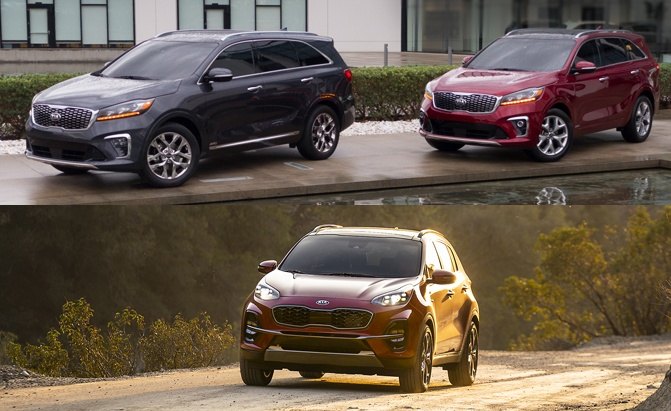
























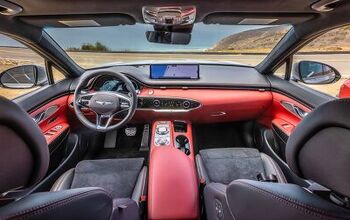
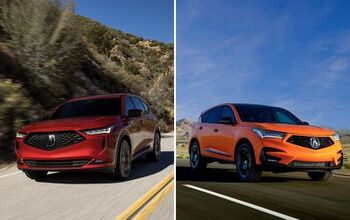

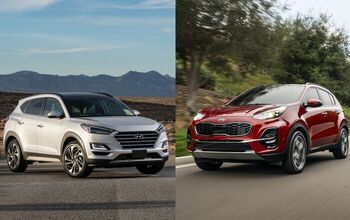
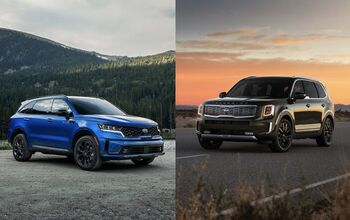











Comments
Join the conversation